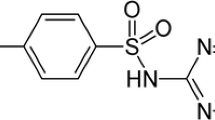Abstract
Human and camel lactoferrin, were labeled with technetium-99m using a simple technique that yielded a labelling efficiency of 98% and stable complexes over time. The camel Lactoferrin was purified. The proteins were investigated for targeting infections in experimental animals. The biodistribution of those labeled proteins in mice infected with Staphylococcus aureus at the femoral muscle was investigated and test ratios of 3.43 and 3.71 were obtained after 60 min for the camel and the human Lactoferrin, respectively. These values were compared to each other and to those reported in the literature, leading us to conclude that the radiotracers are efficient.






Similar content being viewed by others
Notes
Albino Wistar male mice weighing 22-34 g obtained from Pasteur institute of Tunis and housed for 1 day before experiments in our laboratory. Mice were treated according to the Ethical Principles and Guidelines for Experiments on Animals (3rd edition 2005). [Swiss Academy of Medical Sciences (SAMS) Swiss Academy of Sciences (SCNAT)].
References
Arnold R, Brewer M, Gauthier J (1980) Bactericidal activity of human lactoferrin: sensitivity of a variety of microorganisms. Infect Immun 28(3):893–898
Lassiter MO, Newsome A, Sams L, Arnold R (1987) Characterization of lactoferrin interaction with Streptococcus mutans. J Dent Res 66(2):480–485
Wolf JS, Li D, Taylor RJ, O’malley BW (2003) Lactoferrin inhibits growth of malignant tumors of the head and neck. J Otorhinolaryngol Relat Spec 65(5):245–249
Welling MM, Feitsma HIJ, Wim Calame W, Pauwels EKJ (1997) Detection of experimental infections with 99mTc-labeled monoclonal antibodies against TNF-alpha and interleukin-8. Nucl Med Biol 24(7):649–655
Nibbering PH, Ravensbergen E, Welling MM, van Berkel LA, van Berkel PHC, Pauwels EKJ, Nuijens JH (2001) Human lactoferrin and peptides derived from its N terminus are highly effective against infections with antibiotic-resistant bacteria. Infect Immun 69(3):1469–1476
Baker EN, Rumball SV, Anderson BF (1987) Transferrins: insights into structure and function from studies on lactoferrin. Trends Biochem Sci 2:350–353
Anderson BF, Baker HM, Norris GE, Rice DW, Baker EN (1989) Structure of human lactoferrin: crystallographic structure analysis and refinement at 2-8A resolution. J Mol Biol 209:711–734
El-agamy EI (2000) Effect of heat treatment on camel milk proteins with respect to antimicrobial factors, a comparaison with co’s and buffalo milk proteins. Food Chem 68:227–232
Pauwels E, Welling M, Feitsma R, Atsma D, Nieuwenhuizen W (1993) The labelling of proteins and LDL with 99mTc: a new direct method employing KBH4 and stannous chloride. Nucl Med Biol 20:825–833
El Hatmi H, Jrad Z, Khorchani T, Dary A, Girardet JM (2014) Fast protein liquid chromatography of camel α-lactalbumin fraction with radical scavenging activity. Emir J Food Agric 26:309–316
Welling MM, Hiemstra PS, van den Barselaar MT, Paulusma- Annema A, Nibbering PH, Pauwels EKJ, Calame W (1998) Antibacterial activity of human neutrophil defensins in experimental infections inmice is accompanied by increased leukocyte accumulation. J Clin Investig 8:1583–1589
Welling MM, Paulusma-Annema A, Balter HS, Pauwels EK, Nibbering PH (2000) Technetium-99m labelled antimicrobial peptides discriminate between bacterial infections and sterile inflammations. Eur J Nucl Med 27:292–301
Welling MM, Agnieszka K, Gorska B, Oliver P, Mikolajczak R, Henia S, Balter Hans I, Feitsma E, Pauwels J (2005) Kit with technetium-99m labelled antimicrobial peptide UBI 29-41 for specific infection detection. J Label Comp Radiopharm 48(9):683–691
Rusckowski M, Gupta S, Liu G, Dou S, Hnatowich DJ (2004) Investigation of a 99mTc-labelled bacteriophages as a potential infection-specific imaging agent. J Nucl Med 45:13–14
De Koster HS, Amons R, Benckhuijsen WE, Feijlbrief M, Schellekens GA, Drijfhout JW (1995) The use of dedicated peptide libraries permits the discovery of high affinity binding peptides. J Immunol Methods 187:179–188
Waterhouse RN (2003) Determination of lipophilicity and its use as a predictor of blood-brain barrier penetration of molecular imaging agents. Mol Imaging Biol 5:376–389
Belhadj-Tahar H, Coulais Y, Cros G, Darbieu MH, Tafani JA, Fabre J, Esquerré JP, Guiraud R (1996) Technetium labeling of Bi, Tri and tetradentate ligands derived from 2 aminocyclopentene-1-dithiocarboxylic acid: characterization and biodistribution of their oxo and nitrido 99mTechnetium complexes. J Nucl Med Biol 23:353–357
Elagamy EI, Ruppanner R, Ismail A, Champagne CP, Assaf R (1996) Purification and characterization of lactoferrin, lactoperoxidase, lysozyme and immunoglobulins from camel’s milk. Int Dairy J 6:129–145
Wilson AA, Inaba T, Fischer N, Dixon LM, Nobrega J, DaSilva JN, Houle S (1998) Derivatives of way 100635 as potential imaging agents for 5-ht 1a receptors: syntheses, radiosyntheses, and in vitro and in vivo evaluation. J Nucl Med Biol 25:769–776
Essouissi I, Ghali W, Saidi M (2010) Synthesis and evaluation of 99mTc-N sulfanilamide ferrocenecarboxamide as bacterial infections detector. Nucl Med Biol 37:821–829
Nibbering PH, Ravensbergen E, Welling MM, van Berkel A, van Berkel PHC, Pauwels EKJ, Nuijens JH (2001) Human lactoferrin and peptides derived from its N terminus are highly effective against infections with antibiotic-resistant bacteria. Infect Immun 69:1469–1476
Visentin R, Giron MC, Bello M, Mazzi U (2004) Technetium-99m labeling of N-[N-(3-diphenylphosphino propionyl) glycyl] cysteine (PN 2 S-OH) and its methyl ester derivative (PN 2 S-OMe). J Nucl Med Biol 31(5):655–662
Singh AK, Verma J, Bhatnagar A, Sen S, Bose M (2003) Tc-99m isoniazid: a specific agent for diagnosis of tuberculosis. World J Nucl Med 2:292–305
Samina R, Mushtaq A, Jehangir M, Salman AM (2006) Direct labeling of isoniazid with technetium-99m for diagnosis of tuberculosis. Radiochim Acta 94:1–6
Nuijens JH, van Berkel PHC, Schanbacher FL (1996) Structure and biological actions of lactoferrin. J Mammary Gland Biol Neoplasia 1:285–295
Sanchez L, Calvo M, Brock JH (1992) Biological role of lactoferrin. Arch Dis Child 67:657–661
Acknowledgements
The authors would like to thank the staff of Pasteur Institute of Tunisia for their cooperation and assistance with some. The authors are also grateful to Pr BEN SLIMANE of the Salah Azaiez Institute of Tunis for generously providing us with radioactive technetium.
Author information
Authors and Affiliations
Corresponding author
Rights and permissions
About this article
Cite this article
Kanoun, A., Salem, I.B., Darghouth, F. et al. 99mTc-Labeled human and camel lactoferrin for detection of Staphylococcus aureus infections. J Radioanal Nucl Chem 317, 177–185 (2018). https://doi.org/10.1007/s10967-018-5924-z
Received:
Published:
Issue Date:
DOI: https://doi.org/10.1007/s10967-018-5924-z




